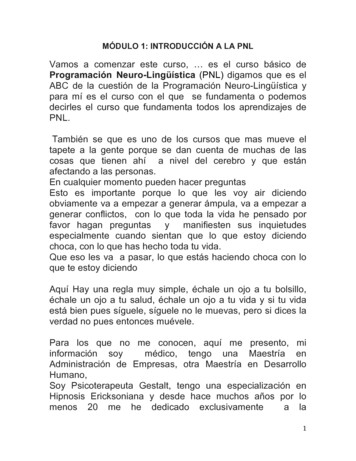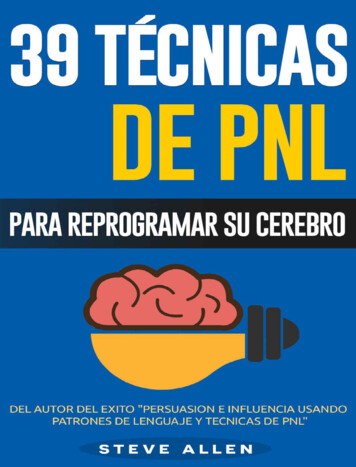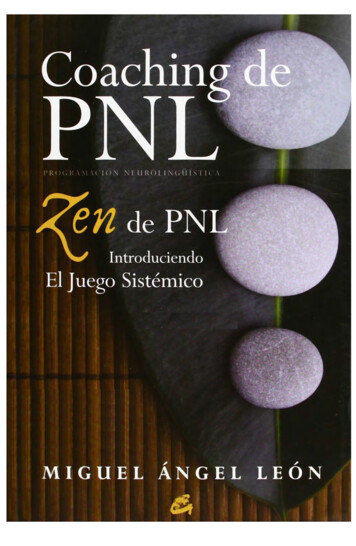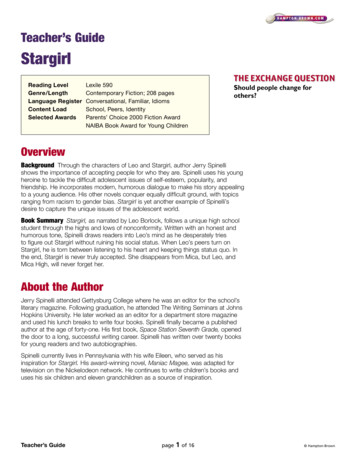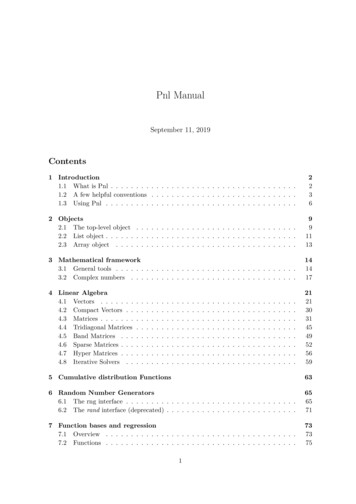
Transcription
Pnl ManualSeptember 11, 2019Contents1 Introduction1.1 What is Pnl . . . . . . . . . . . . . . . . . . . . . . . . . . . . . . . . . . . . .1.2 A few helpful conventions . . . . . . . . . . . . . . . . . . . . . . . . . . . . .1.3 Using Pnl . . . . . . . . . . . . . . . . . . . . . . . . . . . . . . . . . . . . . .22362 Objects2.1 The top-level object . . . . . . . . . . . . . . . . . . . . . . . . . . . . . . . .2.2 List object . . . . . . . . . . . . . . . . . . . . . . . . . . . . . . . . . . . . . .2.3 Array object . . . . . . . . . . . . . . . . . . . . . . . . . . . . . . . . . . . .9911133 Mathematical framework3.1 General tools . . . . . . . . . . . . . . . . . . . . . . . . . . . . . . . . . . . .3.2 Complex numbers . . . . . . . . . . . . . . . . . . . . . . . . . . . . . . . . .1414174 Linear Algebra4.1 Vectors . . . . . . .4.2 Compact Vectors . .4.3 Matrices . . . . . . .4.4 Tridiagonal Matrices4.5 Band Matrices . . .4.6 Sparse Matrices . . .4.7 Hyper Matrices . . .4.8 Iterative Solvers . .212130314549525659.5 Cumulative distribution Functions636 Random Number Generators6.1 The rng interface . . . . . . . . . . . . . . . . . . . . . . . . . . . . . . . . . .6.2 The rand interface (deprecated) . . . . . . . . . . . . . . . . . . . . . . . . . .6565717 Function bases and regression7.1 Overview . . . . . . . . . . . . . . . . . . . . . . . . . . . . . . . . . . . . . .7.2 Functions . . . . . . . . . . . . . . . . . . . . . . . . . . . . . . . . . . . . . .7373751
8 Numerical integration8.1 Overview . . . . . . . . . . . . . . . . . . . . . . . . . . . . . . . . . . . . . .8.2 Functions . . . . . . . . . . . . . . . . . . . . . . . . . . . . . . . . . . . . . .8080809 Fast Fourier Transform9.1 Overview . . . . . . . . . . . . . . . . . . . . . . . . . . . . . . . . . . . . . .9.2 Functions . . . . . . . . . . . . . . . . . . . . . . . . . . . . . . . . . . . . . .81818310 Inverse Laplace Transform8511 Ordinary differential equations11.1 Overview . . . . . . . . . . . . . . . . . . . . . . . . . . . . . . . . . . . . . .11.2 Functions . . . . . . . . . . . . . . . . . . . . . . . . . . . . . . . . . . . . . .86868712 Optimization12.1 Linear constrained optimization (linear programming) . . . . . . . . . . . . .12.2 Nonlinear constrained optimization . . . . . . . . . . . . . . . . . . . . . . . .88888913 Root finding13.1 Overview . . . . . . . . . . . . . . . . . . . . . . . . . . . . . . . . . . . . . .13.2 Functions . . . . . . . . . . . . . . . . . . . . . . . . . . . . . . . . . . . . . .91919314 Special functions14.1 Real Bessel functions . . . . .14.2 Complex Bessel functions . .14.3 Error functions . . . . . . . .14.4 Gamma functions . . . . . . .14.5 Digamma function . . . . . .14.6 Incomplete Gamma functions14.7 Exponential integrals . . . . .14.8 Hypergeometric functions . .9596979798999910010115 Some bindings10115.1 MPI bindings . . . . . . . . . . . . . . . . . . . . . . . . . . . . . . . . . . . . 10115.2 The save/load interface . . . . . . . . . . . . . . . . . . . . . . . . . . . . . . 10316 Financial functions103Index1051Introduction1.1What is PnlPnl is a scientific library written in C and distributed under the Gnu Lesser General PublicLicence (LGPL). This manual is divided into four parts. Mathematical functions: complex numbers, special functions, standard financial functions for the Black & Scholes model.2
Linear algebra : vectors, matrices (dense and sparse), hypermatrices, tridiagonal matrices, band matrices and the corresponding routines to manipulate them and solve linearsystems. Probabilistic functions: random number generators and cumulative distribution functions. Deterministic toolbox : FFT, Laplace inversion, numerical integration, zero searching,multivariate polynomial regression, . . .1.2A few helpful conventions All header file names are prefixed by pnl and are surrounded by the preprocessorconditionals#ifndef PNL MATRIX H#define PNL MATRIX H.#endif /* PNL MATRIX HAll the header files are protected by an extern "C" declaration for possible use with aC compiler. The header files must be include using#include "pnl/pnl xxx.h" All function names are prefixed by pnl except those implementing complex numberarithmetic which are named following the C99 complex library but using a capitalisedfirst letter C.For example, the addition of two complex numbers is performed by the function Cadd. Function containing create in their names always return a pointer to an objectcreated by one or several calls to dynamic allocation. Once these objects are notused, they must be freed by calling the same function but ending in free. A function pnl foo create yyy returns a PnlFoo * object (note the “ ”) and a functionpnl foo bar create yyy returns a PnlFooBar * object (note the “ ”). These objectsmust be freed by calling respectively pnl foo free or pnl foo bar free. Functions ending in clone take two arguments src and dest and modify dest to makeit identical to src, ie. they have the same size and data. Note that no new object isallocated, dest must exist before calling this function. Functions ending in copy create a new object identical (ie. with the same size andcontent) as its argument but independent (ie. modifying one of them does not alter theother). Calling A pnl xxx copy(B) is equivalent to first calling A pnl xxx new()function and then pnl xxx clone(A, B).3
Every object must implement a pnl xxx new function which returns a pointer to anempty object with all its elements properly set to 0. This means that the objectsreturned by the pnl xxx new functions can be used as output arguments for functionsending in inplace for instance. They are suitable for being resized. Functions containing wrap in their names always return an object, not a pointer toan object, and do not make any use of dynamic allocation. The returned object mustnot be freed. For instance, a function pnl foo wrap xxx returns an object PnlFoo anda function pnl foo bar wrap xxx returns an object PnlFooBarPnlVectComplex *v1;PnlVectComplex v2;v1 pnl vect complex create from scalar (5, Complex(0., 1.));v2 pnl vect complex wrap subvect (v1, 1, 2);.pnl vect complex free (&v1);The vector v1 is of size 5 and contains the pure imaginary number i. The vector v2only provides a view to v1(1:1 2), which means that modifying v2 will also modify v1and vice-versa because v1 shares part of its data with v2. Note that only v1 must befreed and not v2. Functions ending in init do not create any object but only perform some internalinitialisation. Hypermatrices, matrices and vectors are stored using a flat block of memory obtainedby concatenating the matrix rows and C-style pointer-to-pointer arrays. Matrices arestored in row-major order, which means that the column index moves continuously. Notethat this convention is not Blas & Lapack compliant since Fortran expects 2-dimensionalarrays to be stored in a column-major order. Type names always begin with Pnl, they do not contain underscores but instead we usecapital letters to separate units in type names.Examples : PnlMat, PnlMatComplex. Object and function names are intimately linked : an object PnlFoo is manipulated byfunctions starting in pnl foo, an object PnlFooBar is manipulated by functions startingin pnl foo bar. In table 1, we summarise the types and their corresponding prefixes. All macro names begin with PNL and are capitalised. Differences between copy and clone methods. The copy methods take a single argument and return a pointer to an object of the same type which is an independent copyof its argument. Example:PnlVect *v1, *v2;4
Pnl typesPnlVectPnlVectComplexPnlVectIntPnl prefixpnl vectpnl vect complexpnl vect intPnlMatPnlMatComplexPnlMatIntpnl matpnl mat complexpnl mat intPnlSpMatPnlSpMatComplexPnlSpMatIntpnl sp matpnl sp mat complexpnl sp mat intPnlHmatPnlHmatComplexPnlHmatIntpnl hmatpnl hmat complexpnl hmat intPnlTridiagMatPnlBandMatpnl tridiag matpnl band matPnlListpnl listPnlBasispnl basisPnlCgSolverPnlBicgSolverPnlGmresSolverpnl cg solverpnl bicg solverpnl gmres solverFigure 1: Pnl typesv1 pnl vect create from scalar (5, 2.5);v2 pnl vect copy (v1);v1 and v2 are two vectors of size 5 with all their elements equal to 2.5. Note that v2must not have been created by a call to pnl vect create xxx because otherwise itwill cause a memory leak. v1 and v2 are independent in the sense that a modificationto one of them does not affect the other.The clone methods take two arguments and fill the first one with the second one.Example:PnlVect *v1, *v2;v1 pnl vect create from scalar (5, 2.5);v2 pnl vect new ();pnl vect clone (v2, v1);5
v1 and v2 are two vectors of size 5 with all their elements equal to 2.5. Note thatv2 must have been created by a call to pnl vect new because otherwise the functionpnl vect clone will crash. v1 and v2 are independent in the sense that a modificationto one of them does not modify the other. All objects are measured using integers int and not size t. Hence, iterations overvectors, matrices, . . . should use an index of type int. In fonctions ending in inplace, the output parameter must be different from any of theinput parameters.1.3Using PnlIn this section, we assume that the library is installed in the directory HOME/pnl-xxx.Once installed, the library can be found in the HOME/pnl-xxx/lib directory and the headerfiles in the HOME/pnl-xxx/include directory.1.3.1Compiling and LinkingThe header files of the library are installed in a root pnl directory and should always beincluded with this pnl/ prefix. So, for instance to use random number generators you shouldinclude#include pnl/pnl random.h Compiling and linking by hand.optionsIf gcc or llvm is used, you should pass the following -I HOME/pnl-xxx/include for compiling -L HOME/pnl-xxx/lib -lpnl for linkingThis does not work straight away on all OS especially if the library is not installed in astandard directory namely /usr/ or /usr/local/ for which you need a privileged writingaccess. On some systems, you may need to add to the linker flags the dependencies of thelibrary, which can become very tedious. Therefore, we provide a second automatic mechanismwhich takes care of the dependencies on its own.Compiling and linking using an automatic Makefile. This mechanism only worksunder Unix (it has been tested under various Linux distributions and Mac OS X).First, you need to create a new directory wherever you want, put in all your code and createa Makefile as belowTo define your target just add the executable name, say my-exec, to the BINS list and create anentry my exec SRC carrying the list of source files needed to create your executable. Note thatif dashes ’-’ may appear in an executable name, the name of the associated variable holdingthe list of source files is obtained by replacing dashes with underscores ’ ’ and adding theSRC suffix.Assume you want to create two binaries : my-exec based on mixed C and C code (file1.cand file2.cpp) and mybinary based on poo1.cxx and poo2.cpp. You can use the followingMakefile.6
## Flags passed to the linkerLDFLAGS ## Flags passed to the compilerCFLAGS ## list of executables to createBINS my-exec mybinarymy exec SRC file1.c file2.cpp# optional flags for compiling and linkingmy exec CFLAGS my exec CXXFLAGS my exec LDFLAGS mybinary SRC poo1.cxx poo2.cpp# optional flags for compiling and linkingmybinary CFLAGS mybinary CXXFLAGS mybinary LDFLAGS ## This line must be the last oneinclude full path to pnl build/CMakeuser.inclLet us comment a little the different variables CFLAGS: global flags used for creating objects based on C code CXXFLAGS: global flags used for creating objects based on C code LDFLAGS: gobal linker flags. binaryname CFLAGS: flags used when creating the objects based on C code and requiredby binaryname binaryname CXXFLAGS: flags used when creating the objects based on C code andrequired by binaryname binaryname LDFLAGS: flags used when linking objects for creating binarynameAn example of such a Makefile can be found in pnl-xxx/perso.Warning: if a file appears in the source list of several binairies, the flags used to compile thisfile are determined by the ones of the first binary involving this file. In the following examplemain.cpp will always be compiled with the flag -O3 even for generating bin2BINS bin1 bin2bin1 SRC main.cpp poo1.cmy exec CXXFLAGS -O37
bin2 SRC main.cpp poo2.cmybinary CXXFLAGS -g -O0## This line must be the last oneinclude full path to pnl build/CMakeuser.inclCompiling and linking using CMake. If you already use CMake for your new project,just add the following to your toplevel CMakeLists.txtfind package(Pnl REQUIRED)set(LIBS {LIBS} {PNL LIBRARIES})include directories( {PNL INCLUDE DIRS})# Deactivate PNL debugging stuff on Release buildsif( {CMAKE BUILD TYPE} STREQUAL "Release")add definitions(-DPNL RANGE CHECK OFF)endif()Then, call cmake with the following extra flag-DCMAKE PREFIX PATH path/to/build-diror add the variable CMAKE BUILD TYPE to the GUI.Just in case, we give an example of a complete although elementary CMakeLists.txtcmake minimum required(VERSION 3.0)# Declare a projectproject(my-project CXX)# Release or Debugif (NOT CMAKE BUILD TYPE)message(STATUS "Setting build type to ’Debug’ as none was specified.")set(CMAKE BUILD TYPE Debug CACHE STRING "Choose the type of build." FORCE)endif ()# Detect PNLfind package(Pnl REQUIRED)set(LIBS {LIBS} {PNL LIBRARIES})include directories( {PNL INCLUDE DIRS})if( {CMAKE BUILD TYPE} STREQUAL "Release")add definitions(-DPNL RANGE CHECK OFF)endif()# Adding an executable.add executable(exec-name list of source files)target link libraries(exec-name {LIBS})add pnl postbuild(exec-name)8
1.3.2Inline Functions and gettersIf it is supported by your compiler, getter and setter functions are declared as inline functions.This is automatically detected when running CMake. By default, setter and getter functionscheck that the required access is valid, basically it boils down to checking whether the indexof the access is within an acceptable range. These extra tests can become very expensivewhen getter and setter functions are intensively called.Thus, it is possible to alter this default behaviour by defining the macro PNL RANGE CHECK OFF. This macro is automatically defined when the library is compiled in Release mode, ie.with -DCMAKE BUILD TYPE Release passed to CMake.2Objects2.1The top-level objectThe PnlObject structure is used to simulate some inheritance between the ojbects of Pnl. Itmust be the first element of all the objects existing in Pnl so that casting any object to aPnlObject is legaltypedef unsigned int PnlType;typedef void (DestroyFunc) (void **);typedef PnlObject* (CopyFunc) (PnlObject *);typedef PnlObject* (NewFunc) (PnlObject *);typedef void (CloneFunc) (PnlObject *dest, const PnlObject *src);struct PnlObject{PnlType type; /*! a unique integer id */const char *label; /*! a string identifier (for the moment not useful) */PnlType parent type; /*! the identifier of the parent object is any,otherwise parent type id */int nref; /*! number of references on the object */DestroyFunc *destroy; /*! frees an object */NewFunc*constructor; /*! New function */CopyFunc*copy; /*! Copy function */CloneFunc*clone; /*! Clone function */};Here is the list of all the types actually definedWe provide several macros for manipulating PnlObejcts. PNL OBJECT (o)Description Cast any object into a PnlObject PNL VECT OBJECT (o)Description Cast any object into a PnlVectObject PNL MAT OBJECT (o)Description Cast any object into a PnlMatObject9
PnlTypePNL TYPE VECTORPNL TYPE VECTOR DOUBLEPNL TYPE VECTOR INTPNL TYPE VECTOR COMPLEXPNL TYPE MATRIXPNL TYPE MATRIX DOUBLEPNL TYPE MATRIX INTPNL TYPE MATRIX COMPLEXPNL TYPE TRIDIAG MATRIXPNL TYPE TRIDIAG MATRIX DOUBLEPNL TYPE BAND MATRIXPNL TYPE BAND MATRIX DOUBLEPNL TYPE SP MATRIXPNL TYPE SP MATRIX DOUBLEPNL TYPE SP MATRIX INTPNL TYPE SP MATRIX COMPLEXPNL TYPE HMATRIXPNL TYPE HMATRIX DOUBLEPNL TYPE HMATRIX INTPNL TYPE HMATRIX COMPLEXPNL TYPE BASISPNL TYPE RNGPNL TYPE LISTPNL TYPE ARRAYTable 1: PnlTypes10Descriptiongeneral vectorsreal vectorsinteger vectorscomplex vectorsgeneral matricesreal matricesinteger matricescomplex matricesgeneral tridiagonal matricesreal tridiagonal matricesgeneral band matricesreal band matricessparse general matricessparse real matricessparse integer matricessparse complex matricesgeneral hyper matricesreal hyper matricesinteger hyper matricescomplex hyper matricesbasesrandom number generatorsdoubly linked listarray
PNL SP MAT OBJECT (o)Description Cast any object into a PnlSpMatObject PNL HMAT OBJECT (o)Description Cast any object into a PnlHmatObject PNL BAND MAT OBJECT (o)Description Cast any object into a PnlBandMatObject PNL TRIDIAGMAT OBJECT (o)Description Cast any object into a PnlTridiagMatObject PNL BASIS OBJECT (o)Description Cast any object into a PnlBasis PNL RNG OBJECT (o)Description Cast any object into a PnlRng PNL LIST OBJECT (o)Description Cast any object into a PnlList PNL LIST ARRAY (o)Description Cast any object into a PnlArray PNL GET TYPENAME (o)Description Return the name of the type of any object inheriting from PnlObject PNL GET TYPE (o)Description Return the type of any object inheriting from PnlObject PNL GET PARENT TYPE (o)Description Return the parent type of any object inheriting from PnlObject PnlObject pnl object create (PnlType t)Description Create an empty PnlObject of type t which can any of the registered types,see Table 1.2.2List objectThis section describes functions for creating an manipulating lists. Lists are internally storedas doubly linked lists.The structures and functions related to lists are declared in pnl/pnl list.h.typedef struct PnlCell PnlCell;struct PnlCell{struct PnlCell *prev; /*! previous cell or 0 */struct PnlCell *next; /*! next cell or 0 */PnlObject *self;/*! stored object */};11
typedef struct PnlList PnlList;struct PnlList{/*** Must be the first element in order for the object mechanism to work* properly. This allows any PnlList pointer to be cast to a PnlObject*/PnlObject object;PnlCell *first; /*! first element of the list */PnlCell *last; /*! last element of the list */PnlCell *curcell; /*! last accessed element,if never accessed is NULL */int icurcell; /*! index of the last accessed element,if never accessed is NULLINT */int len; /*! length of the list */};Important note: Lists only store addresses of objects. So when an object is inserted into alist, only its address is stored into the list. This implies that you must not free any objectsinserted into a list. The deallocation is automatically handled by the function pnl list free. PnlList pnl list new ()Description Create an empty list PnlCell pnl cell new ()Description Create an cell list PnlList pnl list copy (const PnlList A)Description Create a copy of a PnlList . Each element of the list A is copied by callingthe its copy member. void pnl list clone (PnlList dest, const PnlList src)Description Copy the content of src into the already existing list dest. The list destis automatically resized. This is a hard copy, the contents of both lists are independentafter cloning. void pnl list free (PnlList L)Description Free a list void pnl cell free (PnlCell c)Description Free a list PnlObject pnl list get ( PnlList L, int i)Description This function returns the content of the i–th cell of the list L. This functionis optimized for linearly accessing all the elements, so it can be used inside a for loopfor instance. void pnl list insert first (PnlList L, PnlObject o)Description Insert the object o on top of the list L. Note that o is not copied in L, sodo not free o yourself, it will be done automatically when calling pnl list free12
void pnl list insert last (PnlList L, PnlObject o)Description Insert the object o at the bottom of the list L. Note that o is not copied inL, so do not free o yourself, it will be done automatically when calling pnl list free void pnl list remove last (PnlList L)Description Remove the last element of the list L and frees it. void pnl list remove first (PnlList L)Description Remove the first element of the list L and frees it. void pnl list remove i (PnlList L, int i)Description Remove the i-th element of the list L and frees it. void pnl list concat (PnlList L1, PnlList L2)Description Concatenate the two lists L1 and L2. The resulting list is store in L1 on exit.Do not free L2 since concatenation does not actually copy objects but only manipulatesaddresses. void pnl list resize (PnlList L, int n)Description Change the length of L to become n. If the length of L id increased, theextra elements are set to NULL. void pnl list print (const PnlList L)Description Only prints the types of each element. When the PnlObject object has aprint member, we will use it.2.3Array objectThis section describes functions for creating and manipulating arrays of PnlObjects.The structures and functions related to arrays are declared in pnl/pnl array.h.typedef struct PnlArray PnlArray;struct PnlArray{/*** Must be the first element in order for the object mechanism to work* properly. This allows any PnlArray pointer to be cast to a PnlObject*/PnlObject object;int size;PnlObject **array;int mem size;};Important note: Arrays only store addresses of objects. So when an object is insertedinto an array, only its address is stored into the array. This implies that you must not freeany objects inserted into a array. The deallocation is automatically handled by the functionpnl array free.13
PnlArray pnl array new ()Description Create an empty array PnlArray pnl array create (int n)Description Create an array of length n. PnlArray pnl array copy (const PnlArray A)Description Create a copy of a PnlArray . Each element of the array A is copied bycalling the A[i].object.copy. void pnl array clone (PnlArray dest, const PnlArray src)Description Copy the content of src into the already existing array dest. The arraydest is automatically resized. This is a hard copy, the contents of both arrays areindependent after cloning. void pnl array free (PnlArray )Description Free an array and all the objects hold by the array. int pnl array resize (PnlArray T, int size)Description Resize T to be size long. As much as possible of the original data is kept. PnlObject pnl array get ( PnlArray T, int i)Description This function returns the content of the i–th cell of the array T. No copyis made. PnlObject pnl array set ( PnlArray T, int i, PnlObject O)Description T[i] O. No copy is made, so the object O must not be freed manually. void pnl array print (PnlArray )Description Not yet implemented because it would require that the structure PnlObjecthas a field copy.3Mathematical framework3.1General toolsThe macros and functions of this paragraph are defined in pnl/pnl mathtools.h.3.1.1ConstantsA few mathematical constants are provided by the library. Most of them are actuallyalready defined in math.h, values.h or limits.h and a few others have been added.14
M EM LOG2EM LOG10EM LN2M LN10M PIM 2PIM PI 2M PI 4M 1 PIM 2 PIM 2 SQRTPIM SQRT2PIM SQRT2M EULERM SQRT1 2M 1 SQRT2PIM SQRT2 PIINT MAXMAX INTDBL MAXDOUBLE MAXDBL EPSILONPNL NEGINFPNL POSINFPNL INFNAN3.1.2e1log2 elog10 eloge 2loge 10π2ππ/2π/41/π2/π 2/ πsqrt2π 2 P n1γ limn ln(n)k 1 k 1/ 21/ 2πp2/π2147483647INT MAX1.79769313486231470e 308DBL MAX2.2204460492503131e 16 Not a NumberA few macros PNL IS ODD (int n)Description Return 1 if n is odd and 0 otherwise. PNL IS EVEN (int n)Description Return 1 if n is even and 0 otherwise. PNL ALTERNATE (int n)Description Return ( 1)n . MIN (x,y)Description Return the minimum of x and y. MAX (x,y)Description Return the maximum of x and y. ABS (x)Description Return the absolute value of x. PNL SIGN (x)Description Return the sign of x (-1 if x 0, 0 otheriwse).15
SQR (x)Description Return x2 . CUB (x)Description Return x3 .3.1.3Classifying a floating–point number double pnl nan ()Description Return NaN double pnl posinf ()Description Return infinity double pnl neginf ()Description Return - infinity int pnl isnan (double x)Description Return 1 if x NaN int pnl isinf (double x)Description Return 1 if x Inf, -1 if x -Inf and 0 otherwise. int pnl isfinite (double x)Description Return 1 if x! -Inf3.1.4Rouding a floating–point number int pnl itrunc (double s)Description This function is similar to the trunc function (provided by the C library)but the result is typed as an integer instead of a double. Digits may be lost if s exceedsMAX INT. long int pnl ltrunc (double s)Description This function is similar to the trunc function (provided by the C library)but the result is typed as a long integer instead of a double. double pnl trunc (double s)Description Return the nearest integer not greater than the absolute value of s. Thisfunction is part of C99 as trunc. double pnl round (double s)Description Return the integral value nearest to x rounding half-way cases away fromzero, regardless of the current rounding direction. This function is part of C99 as round. int pnl iround (double s)Description This function is similar to the round function (provided by the C library)but the result is typed as an integer instead of a double. Digits may be lost if s exceedsMAX INT. long int pnl lround (double s)Description This function is similar to the round function (provided by the C library)but the result is typed as a long integer instead of a double.16
3.1.5Some standard mathematical functions double pnl fact (double x)Description See pnl sf fact double pnl lgamma (double x)Description See pnl sf log gamma double pnl tgamma (double x)Description See pnl sf gamma double pnl acosh (double x)Description Compute acosh(x). double pnl asinh (double x)Description Compute asinh(x). double pnl atanh (double x)Description Compute atanh(x). double pnl log1p (double x)Description Compute log(1 x) accurately for small values of x double pnl expm1 (double x)Description Compute exp(x)-1 accurately for small values of x double pnl cosm1 (double x)Description Compute cos(x)-1 accurately for small values of x double pnl pow i (double x, int n)Description Compute x n for an integer n.3.1.6Comparison of floating–point numbers int pnl isequal rel (double x, double y, double relerr)Description Compare two floating–point numbers up to a relative precision relerr int pnl isequal abs (double x, double y, double abserr)Description Compare two floating–point numbers up to an absolute precision abserr int pnl isequal (double x, double y, double relerr)Description Equivalent to pnl isequal abs if x 1 and to pnl isequal abs otherwise.3.23.2.1Complex numbersOverviewThe complex type and related functions are defined in the header pnl/pnl complex.h.The first native implementation of complex numbers in the C language appeared in C99,which is unfortunately not available on all platforms. For this reason, we provide here animplementation of complex numbers.17
typedef struct {double r; /*! real part */double i; /*! imaginary part */} dcomplex;3.2.2ConstantsCZEROCONECI3.2.30 as a complex number1 as a complex numberI the unit complex numberFunctions double, double CMPLX (dcomplex z)Description z.r, z.i dcomplex Complex (double x, double y)Description x i y dcomplex Complex polar (double r, double theta)Description r exp(i theta) double Creal (dcomplex z)Description R(z) double Cimag (dcomplex z)Description Im(z) dcomplex Cadd (dcomplex z, dcomplex b)Description z b dcomplex CRadd (dcomplex z, double b)Description z b dcomplex RCadd (double b, dcomplex z)Description b z dcomplex Csub (dcomplex z, dcomplex b)Description z-b dcomplex CRsub (dcomplex z, double b)Description z-b dcomplex RCsub (double b, dcomplex z)Description b-z dcomplex Cminus (dcomplex z)Description -z dcomplex Cmul (dcomplex z, dcomplex b)Description z*b18
dcomplex RCmul (double x, dcomplex z)Description x*z dcomplex CRmul (dcomplex z, double x)Description z * x dcomplex CRdiv (dcomplex z, double x)Description z/x dcomplex RCdiv (double x, dcomplex z)Description x/z dcomplex Conj (dcomplex z)Description z dcomplex Cinv (dcomplex z)Description 1/z dcomplex Cdiv (dcomplex z, dcomplex w)Description z/w double Csqr norm (dcomplex z)Description Re(z)2 im(z)2 double Cabs (dcomplex z)Description z dcomplex Csqrt (dcomplex z)Description sqrt(z) , square root (with positive real part) dcomplex Clog (dcomplex z)Description log(z) dcomplex Cexp (dcomplex z)Description exp(z) dcomplex CIexp (double t)Description exp( it ) dcomplex Cpow (dcomplex z, dcomplex w)Description z w , power function dcomplex Cpow real (dcomplex z, double x)Description z x , power function dcomplex Ccos (dcomplex z)Description cos(g) dcomplex Csin (dcomplex z)Description sin(g) dcomplex Ctan (dcomplex z)Description tan(z)19
dcomplex Ccotan (dcomplex z)Description cotan(z) dcomplex Ccosh (dcomplex z)Description cosh(g) dcomplex Csinh (dcomplex z)Description sinh(g) dcomplex Ctanh (dcomplex z) 2zDescription tanh(z) 1 e1 e 2z dcomplex Ccotanh (dcomplex z)1 e 2zDescription cotanh(z) 1 e 2z double Carg (dcomplex z)Description arg(z) dcomplex Ctgamma (dcomplex z)Description Gamma(z), the Gamma function dcomplex Clgamma (dcomplex z)Description log(Gamma (z)), the logarithm of
Linearalgebra: outinestomanipulatethemandsolvelinear
